Container orchestration is a critical component of modern software development and deployment, particularly in the context of platform engineering. It involves the automated management of containers, ensuring efficient deployment, scaling, and lifecycle management. This comprehensive guide delves into the technical aspects of container orchestration, exploring its core concepts, tools, and use cases.
What Is Container Orchestration?
Container orchestration is the process of managing multiple containers that work together as part of an application infrastructure. It automates the deployment, scaling, and lifecycle management of containers, freeing engineers from manual intervention. This process is crucial for large-scale applications, where managing thousands of containers manually is impractical.
Key Concepts
Declarative Programming: Modern orchestration tools use declarative programming, which allows engineers to define the desired outcome without specifying step-by-step details. This approach simplifies container deployments and management.
Container Life Cycle: The container life cycle includes build, deploy, and run phases. Orchestration tools automate these phases, ensuring efficient management of containers.
Tools and Platforms
Several tools and platforms are available for container orchestration:
Docker Swarm: Docker Swarm is a fully integrated and open-source container orchestration tool. It is ideal for organizations that prefer a less complex orchestrator than Kubernetes for smaller applications.
Apache Mesos: Apache Mesos offers a lightweight, high-availability, and cross-platform orchestration platform. It is suitable for large enterprises and supports several popular languages.
Nomad: Nomad is an open-source workload orchestration tool that can be used as a Kubernetes alternative or supplement. It is ideal for both small and enterprise uses.
Kubernetes: Kubernetes is a leading container orchestration tool, revolutionizing how applications are deployed, scaled, and managed. It provides robust features to automate application container deployment, scaling, and management.
Orchestration Workflow
A typical orchestration workflow involves the following steps:
# Code
developer_commits_code()
# Validate
ci_cd_platform_submits_request_for_validation()
# IdP Response
if validation_successful:
pipeline_triggers_common_tasks()
# Request
provisioner_executes_requested_patterns()
Use Cases
Container orchestration is necessary when:
- Complexity: Applications use more than a couple of containers, making manual management impractical.
- Scaling: Container orchestration tools support declarative programming, making it easy to spin up new containers and balance loads.
Conclusion
Container orchestration is a critical component of modern software development and deployment. By understanding the core concepts, tools, and use cases, organizations can leverage container orchestration to streamline their application management and improve efficiency.


















